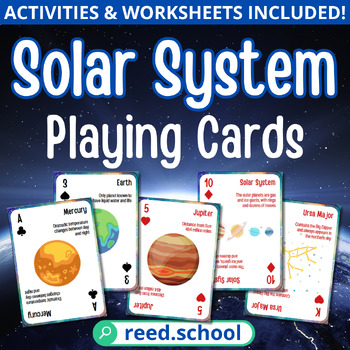Solar System Playing Cards Game: Outer Space Scavenger Hunt & Scaled Model
- Zip
Description
Explore the wonders of our solar system with "Solar System Playing Cards," a captivating and educational playing card deck designed to ignite curiosity about outer space in students of all ages! With visually stunning artwork and comprehensive information, this unique resource is perfect for teachers, educators, homeschoolers, and astronomy enthusiasts seeking to make the study of space engaging and enjoyable.
To get the most out of the deck, I have included a 5-page solar system scavenger hunt that students complete by using the information on the cards. Also included is a solar system scaled model project with exact measurements to space out the cards in the classroom or down the hall! A full suggested activity page details other suggested ways to use the deck and get the most learning out of it.
Key Features:
- Galactic Artwork: Feast your eyes on meticulously crafted artwork that brings the planets, moons, spacecraft, telescopes, stars, and more to life. Our Solar System Explorers deck stands out with its exceptional visual appeal, offering a truly immersive learning experience.
- Educational Quick Facts: Each card boasts four quick facts, presenting essential information about the celestial objects and space missions. Delve into the mysteries of the solar system, learn fascinating details about each planet, and discover the incredible feats of space exploration.
- Distance & Orbital Periods: Discover the secrets of space distances and orbital periods as you explore the deck. The diamond suits reveal the distance of each planet from the sun, while the heart suits showcase the number of Earth days it takes for each planet to complete an orbit.
- Versatility with Playing Card Symbols: Beyond being an educational resource, "Solar System Playing Cards" offers endless possibilities for fun and engaging games. With standard playing card symbols incorporated into the design, you can enjoy classic card games while mastering the mysteries of the cosmos.
- Suggested Page of Activities: Accompanying the deck is a downloadable worksheet packed with educational activities, making lesson planning a breeze for educators. Whether you're teaching in the classroom or guiding homeschool studies, this resource is a valuable addition to your teaching toolkit.
Card details:
1. Size: 3.5" x 2.5"
2. Aces: Mercury, 2s: Venus, 3s: Earth, 4s: Mars, etc.
3. Four moons (Moon, Callisto, etc.), the Sun, constellations, black hole, and supernova make up the other cards
Related Product:





